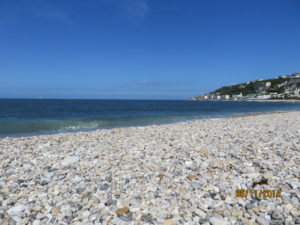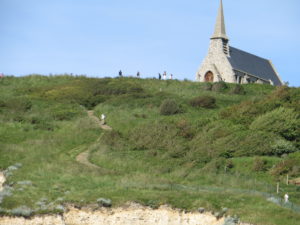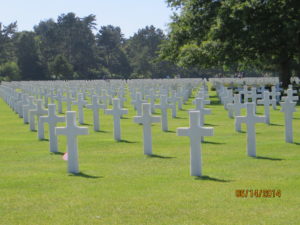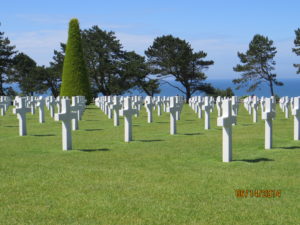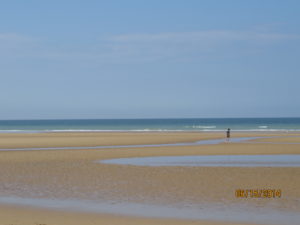(Le Havre, Être tat, Normandy, all in France – 19 June 2014) Finding people who have become enamored with all things French is not difficult. They even have a name, Francophiles. Despite my French heritage, something Jessica loves to tease me about, I am not, nor is Jessica, particularly smitten by France. Visiting Paris has always been on our agenda, and we will do so next month when we travel there and back from London. But as far as the rest of France goes, we were truly at a loss when came time to fill our travel plans with French destinations.
Searching online for recommendations proved to be of limited use. Several people said you cannot go wrong no matter where you are in France. Good to know, but unhelpful for our purpose.
In the end, we left Geneva and traveled straight westward across France, cutting right through the middle of Paris, [just as Austin enjoys being at the center of Texas, Paris does the same in France], on our way to a region of France known as Normandy on the west coast. A change of trains connected by a bus ride through Paris gave us an exciting teaser of what we could expect when returning to Paris later.
Normandy was home to a solid list of tourist attractions, including Omaha Beach (site of the D-Day invasion). Additionally, we could easily catch a ferry from Normandy to England, our next stop.
Le Havre Splits the Middle
Finding an affordable place to stay in France was challenging. We tried every travel trick we knew, but were always thwarted by the high cost. We even explored staying in a ready-made tent at some campgrounds, but the summer travel season was already in full swing and nothing was available. AirBnB had come through for us on three previous occasions, so why not try it again? Bingo! We found a room for rent from a single mom with two teenage kids. This could get interesting.
The room-for-rent we’d found was in the port city of Le Havre (pronounced “Lou-ahv“). The location looked good on the map since we could get there directly by train, and then easily go north to see Être tat and south to Omaha Beach.
It was all working out perfectly. Agnes, our host at the house, was a history teacher and also a chaperone for French exchange students studying in the US. This made her both full of interesting stories, but also full of compassion and understanding for us as new arrivals to France.
As a city, Le Havre itself had its share of notable sites. It suffered extensive damage during WWII and many of the waterfront buildings were rebuilt rather boringly since that time. Of far greater interest was a very unchurch like looking church set back a couple of blocks from the water’s edge. Its prominent feature was a colossal tower that resembled the UT Tower in Austin much more than the spire of any church we had ever seen. It was built in the 1950’s partly as a memorial to the 5,000 Le Havre citizens that died during the war.
Le Havre had a lively boardwalk scene just behind the “beach.” The problem was that this beach had no sand, only smoothed stones of varying sizes. One could lay out on the rocks and enjoy the surf, but without actual sand, it’s just not the same.
More than anything else, Le Havre was important to us for being our first French city. The language, the people, the pastries…all so very French. Enter any shop and you’ll hear the dainty, charming, disarming greeting, “Bonjour.” I’m embarrassed to admit just how sweet and beguiling they make it sound. I tried to mimic it, but the result was just silly. They have it, I don’t.
Être tat is a cliff-lined section of the French coast famous for its natural arches that walk out of the ocean becoming land at first step. Unique and spectacular views are provided in every direction. All the more, Jessica and I were there on a beautiful day.
A tiny church was placed atop one of the cliffs and next to it, a war museum.
We walked on the high side and also the low, down by the water’s edge. The tide was out enabling us to walk to the left edge of the beach until the small stones that substituted for sand gave way to broad, slime-surfaced rocks, quite slippery indeed. All the care in the world didn’t prevent Jessica from taking a swoosh-dip right onto her butt, giving her tailbone quite a jolt. Shaken but not deterred, we continued, this time holding hands for extra security.
It seemed that our walk would be turned around as we arrived at a finger of land cutting straight out to the ocean, signaling a dead-end and the beach’s furthermost point. If only there was a tunnel that would take us through the sandstone to the beach on the other side. Yes, by now we could see a trickle of people coming from somewhere in the rocks. There was indeed a tunnel, accessible only when the tide is out. We scrambled to its entrance, read the signs warning of danger if the tides come in (written in both French and English), and walked into the damp darkness. Truly, the tunnel never got very dark and not 50 steps later we emerged to the deserted beach on the other side. It was a fun little adventure and oh so breathtakingly beautiful.
Omaha Beach
Our day to visit Omaha beach came about one week after the US President and other world leaders were there marking the 70th anniversary of the D-Day invasion. [Wouldn’t that have been something if we’d run into Obama in France?] By the time we’d arrived, most signs of celebration were gone, though we did see many houses flying US, British and French flags. Our sense was that even after 7 decades had passed memories of the war and the gratitude felt by the French people towards America were still intact.
Getting to and from Omaha beach from Le Havre was no easy feat, despite being little more than an hour and a half away. There was no straight shot by bus or train; only a combination of methods would do the trick. Cost was always a concern for us, too. Where we found advantage was in our pace. At this point, we were three-quarters of the way through our trip and pretty comfortable knowing we can flexibly manage any situation. Good thing, too. Because a labor strike led to the cancellation of one of the trains we needed to take. Another train would follow, but not for a couple of hours. Hmmm, how does one spend two hours in a small city called Caen in France?
We concluded that a couple of hours is an awkward amount of time to have in a city you’ve never been to before. We didn’t want wander too far off course and risk missing our next connection. So, we basically found lunch and wifi in a Chinese restaurant and waited.
Too bad we didn’t have time to visit one of the many WWII-related museums in Caen. Prior to our day-trip to Omaha Beach, Jessica and I both boned-up on our history. This came in the form of watching a History Channel documentary AND the opening sequence to Saving Private Ryan.
Rows of White Crosses
Once at the Omaha Beach memorial site, it was all quite moving. Rows and rows of white crosses, each bearing the names and hometowns of US soldiers killed in action on this remote French coast. We walked slowly past them, stopping occasionally to notice the names and places. Soldiers from Texas always caught our eyes…and there were many of them. Some of the grave markers sadly pronounced that the entombed remains were “unknown.”
Blended around and within the cemetery were war-memorials and tiny chapels. A web of walkways connected everything together. On the side of the cemetery that faces the English Channel, there were paths angling down through the dunes towards the long stretch of Omaha beach. Hidden within those dunes 70 years ago were the German soldiers, firing their machine guns at the incoming waves of GI’s.
The beach where the D-Day landing took place is both intense, for reasons of history, and immense, for it’s sheer size. I’ve never seen such a great span of sand between the surf and where the dunes begin. Somberly walking that distance, Jessica and I had plenty of time to imagine what it was like for the GI’s to run the expanse while a gauntlet of bombs and bullets met them head-on.
On the beach itself, almost nothing remains of the epic battle that turned this placid scene into hell. The only thing we saw was a war-era transport boat of some kind; buried by sand almost completely until only it’s outline showed through.
Still Grateful
That train cancellation from earlier in the day was now creating difficulties we couldn’t have foreseen. It was now too late in the day for us to catch a shuttle back from Omaha Beach to the nearest town. We could have called for a taxi, but that would have cost us a bloody fortune and we truly were not carrying enough cash on us, anyway. Instead, I went out to the parking lot and started (indirectly) asking for a ride. “Excuse me, I’m trying to get back to Bayeux. Do you know of any buses still running?”
The first person I asked was the driver (and owner) of a sightseeing tour van. “Are you American?” he asked, almost certainly recognizing my Yankee accent. He was clearly British. [Yes, we were in France, but it seemed commonplace for Brits to make their home in France.] “Sure, I can give you a ride,” he reassured me. Though, he did feel obligated to ask permission of the Singaporean family that had already paid money for this tour that was still happening. Thankfully, they agreed.
The guide was super nice to give us a ride. Yes, mostly he was just a really nice guy with a great attitude, but also…it was clear that some portion of it was gratitude. We were American, and in this part of the world that meant a lot 70 years ago and it still does today.
Though bailed out of one jam, our travel challenges weren’t through. From Bayeux we caught a train back to Caen, but then hit a true dead-end. No more buses or trains were heading back to Le Havre until morning. We were stuck!
In desperation, I sent a text to our French AirBnB host, Agnes. It was a cry for help. After some delays, and as night was falling, we finally made contact with her by phone. She told us not to worry. That she would come and pick us up in her car. This seemed nothing short of heroic to us. She so easily could have said, I’m sorry, I don’t know what I can do to help you. But that wasn’t how she operated. Having been a chaperon for exchange students before, I guess she was used to coming to the rescue.
Anyone that says the French don’t like Americans hasn’t met Agnes. She was so nice to us. We paid her what money we had to help her with gas and the toll roads between Le Havre and Caen and back. I still question whether it was enough.
Before saying good-bye to Agnes, Le Havre and the Normandy coast of France, we think one other memory is worth a mention.
Movies, le cinema, are an important part of the French culture. Small, two or three screen movie theaters are everywhere. One leisurely-paced day in Le Havre, Jessica and I wandered into an old theater just to see if there was anything interesting showing in English. We spotted a movie with Tommy Lee Jones and Hillary Swank called, The Homesman. It touted some awards from the Cannes Film Festival, so we went for it. Jessica pretty much hated it and I liked it only a tad more. Nonetheless, it was a worthy side-step and we were both glad for the experience of watching a movie (in English) in Le Havre, France.
The next stop on our journey was London. We’d get there by crossing the English Channel by ferry from Le Havre, France to Portsmouth, England. For Jessica, London was the most highly anticipated destination of our entire trip. To hear her say it, “I’ve been waiting my whole life to go back to London.” (It’s where she was born, in case anyone’s forgotten.)



